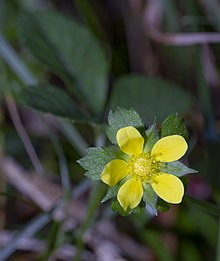Potentilla indica
| Potentilla indica | |
|---|---|

| |
| Scientific classification | |
| Kingdom: | Plantae |
| Clade: | Tracheophytes |
| Clade: | Angiosperms |
| Clade: | Eudicots |
| Clade: | Rosids |
| Order: | Rosales |
| Family: | Rosaceae |
| Genus: | Potentilla |
| Species: | P. indica
|
| Binomial name | |
| Potentilla indica (
Th.Wolf | |
| Synonyms[1] | |
| |
Potentilla indica, known commonly as mock strawberry,
Many sources consider this plant part of the genus Potentilla[1][7][3][5][8][9][10][11] due to evidence from chloroplast genetic sequence data that the genus Duchesnea is included within Potentilla,[12] though some still list it as Duchesnea indica.[13]
Description

The leaves are
trifoliate, roughly veined beneath, dark green, and often persisting through the winter, arising from short crowns. The plant spreads along creeping stolons, rooting and producing crowns at each node. The yellow flowers are produced in mid spring, then sporadically throughout the growing season. The aggregate accessory fruits are white or red, and entirely covered with red achenes, simple ovaries, each containing a single seed.[14][15]

Uses
The fresh berries are edible but considered less palatable than proper strawberries.[16][17]
References
- ^ a b c d "Potentilla indica (Andrews) Th.Wolf". Plants of the World Online. Royal Botanic Gardens, Kew. Retrieved 1 May 2020.
- ^ a b Missouri department of Conservation. "Indian Strawberry (Mock Strawberry)". Retrieved 22 November 2013.
- ^ a b "Potentilla indica". Go Botany. New England Wildflower Society. Retrieved 1 May 2020.
- ^ O’Brien, Meghan (December 2006). "Indian Strawberry". Bellarmine University. Retrieved 2017-06-13.
- ^ a b c "Potentilla indica". County-level distribution map from the North American Plant Atlas (NAPA). Biota of North America Program (BONAP). 2014.
- ^ "Invasive species in Belgium: Duchesnea indica". Retrieved 22 November 2013.
- ^ Brouillet L, Desmet P, Coursol F, Meades SJ, Favreau M, Anions M, Bélisle P, Gendreau C, Shorthouse D, et al. (2010). "Potentilla indica". data.canadensys.net. Database of Vascular Plants of Canada (VASCAN). Retrieved 1 May 2020.
- ^ Weakley, Alan S. (2018), Flora of the Southern and Mid-Atlantic States, working draft of 20 August 2018, University of North Carolina Herbarium, North Carolina Botanical Garden, University of North Carolina at Chapel Hill
- ^ Reznicek, A. A.; Voss, E. G.; Walters, B. S., eds. (February 2011). "Potentilla indica". Michigan Flora Online. University of Michigan Herbarium. Retrieved 1 May 2020.
- ^ "Taxonomy - GRIN-Global Web v 1.10.6.2". npgsweb.ars-grin.gov. Retrieved 8 May 2020.
- .
- S2CID 22378156.
- ^ "World Flora Online: Duchesnea Sm". World Flora Online Consortium. 2020. Retrieved 30 March 2020.
- ^ Ertter, Barbara (2012). "Duchesnea indica var. indica". ucjeps.berkeley.edu. Retrieved 2 May 2020.
- ^ University of Missouri: Division of Plant Sciences
- )
- ^ "Are the mock strawberries toxic?". FDA Poisonous Plant Database. 1986. Archived from the original on 2021-05-22. Retrieved 2022-06-16.



